Myanmar Nov 8-22, 2013
Myanmar is a booming tourist destination. But the infrastructure isn’t here to deal with the crowds of backpackers, especially in the busy months of November to March. As an independent traveler who is used to booking hotels on short notice or more often not at all, finding a place to sleep in the cheap price range I am used to can be difficult, especially in Yangon, Inle Lake and Mandalay. Popular booking sites, like Hostelworld, have zero listings for the country. Agoda.com is the only booking site with listings, but all the cheap ones are gone quickly. Agoda does not give refunds. It is easy to find hotels in the $50+ range and above though, but I never pay that much. Rather than travelling day-to-day, construct an itinerary, and book early. During festivals, it is especially difficult. Myanmar is hosting the 27th SEA (South East Asia) Games in December 2013, and difficulties are expected to increase. Everything is changing fast as this country opens up and proceeds with its experiment in democracy.
Money. Concerning money, forget most things you have read. In Yangon, ATMs are everywhere and are becoming more common elsewhere. I bought US cash and did not avail myself of ATMs, so do not know about their reliability. On the street I was able to exchange 1000 kyat to the $US, money changers and banks gave 965 and hotels slightly less. I was able to get the same rate for all denominations. The black market for money should be avoided as it is cumbersome and one is more likely to be taken advantage of. It is OK for the bill to have folds but other defects will make them not exchangeable. Policies will vary with every institution and will be changing with time. I saw some people virtually examining the bills with a magnifying glass as their hotel had very rigid policies. Obviously torn bills should not be accepted but I never saw any and businesses were not examining bills carefully. You end up with an incredible wad of money, especially if the notes are 1000 denominations. You still get a wad if they are 5000 denominations, think paying for everything with $5 bills. One ends up carrying around a lot of cash. Hotels, airlines, and train tickets must be paid in dollars but kyat are used everywhere else. The tourist towns of Bagan, Bago, Inle Lake and Mandalay charge tourists to enter (!0 $US or Euros), so have $US dollars here. Prices listed in Lonely Planet are hopelessly out of date. Expect to pay 3-4 times that amount. Hotels in Myanmar are more expensive than hostels in SE Asia, but everything else, especially food and taxis are very cheap. Credit cards are charged 7% extra and rarely used. Travelers cheques would be useless.
I arranged my visa in Bangkok. It is easy and well-organized. Two small businesses near the Myanmar Embassy offer the forms and some advice for minimal costs. Stop there, get the form and a photocopy of your passport, and supply 2 passport photos. The embassy is open for accepting the application from 9-12, and for pickup of the completed visa from 3:30 to 4:30. Lines stretch down the block for each time, but they moved surprisingly fast. Same day processing costs ~$40 (1,335 Baht) and must be accompanied with your flights. Later processing does not need flights. Next day costs ~$30 (1,015 Baht) and two days costs ~$26 (810 Baht), but because of the pickup time, you would still need to be staying in Bangkok that night unless you have a late flight. I booked my return flight with one days notice on Bangkok Air for $537. I met several much more organized travelers who had bought their tickets 1-2 months previously on Air Asia for $80! I have a hard time being that organized but they are paying the price of not having flexible travel schedules. There are no shuttles or buses from the airport, but taxis are very cheap (about 8000 kyat for the one hour trip).
YANGON. To get a picture of Yangon (Formerly Rangoon. It is no longer the capital but is the major economic hub of Myanmar. Population 7 million), think of India with Oriental-looking people and less horn blaring, and no cows. Motorcycles and bicycles are against the law in Yangon. Trishaws (bicycles with a sidecar that can carry two people) are common. Downtown streets are busy and the sidewalks are full of vendors selling everything but mostly food. English is generally poor except in the hotels.
Most everyone wears a longhi. The women’s faces are smeared with yellow opaque cream, used as a sunscreen as it is best not to be tanned. I wandered around downtown and visited several “sites”.
Moseah Yeshua Synagogue, built in 1890, is open from 9:30 to 12:00 except Sundays and has a lovingly maintained interior for the city’s now tiny congregation of 25 Jews. The large mosque just down the street is interesting.
Sule Paya is a 2,000-year-old Buddhist temple occupying the largest traffic circle in the city – the ‘gold’ stupa is a landmark in downtown Yangon. The Myanmar style of Buddhist architecture (like most countries) is unique with plain interiors and a heavy emphasis on gilding. All the Buddha’s heads are surrounded by flashing neon.
Mahabandoola Garden is a pleasant oasis of grass and trees and contains the Independence Monument. Across the street is a Baptist Church, refreshing in its simplicity. Old British colonial buildings are common in this part of the city. The east part of the riverside is industrial with warehouses and cranes, and the Strand is a busy, exhaust-filled street.
Koeng Hock Keong is Yongon’s largest Chinese Temple. I talked to an older man with wonderful English here. He was schooled In English schools prior to independence and worked in the tourist industry all his life. These older guys seem to have the best English.
Shwedagon Paya is the city’s defining image and has been a symbol of Burmese identity for 2,500 years. The compound with its main zedi (stupa) and 82 other buildings is astounding any time of the day, but evening and sunrise, when the light hits the gilding are the best times to visit. Paya means ‘Holy one” or religious monument. Shwedagon is said to be built on a hill where Buddha relics have been enshrined, including eight hairs of Buddha. The zedi is 98m tall and over the years has supposedly accumulated 53 metric tons of gold leaf. The top of the spire is encrusted with over 5000 diamonds and 2000 other stones. We went in the evening by taxi for 2000 kyat. Though there are elevators, I would encourage you to walk up one of the huge, graceful stairways (one for each direction). The stupa is surrounded by eight ‘corners’, one for each day of the week plus one extra. Using the day of the week on which they were born, one pours cups of holy water over a Buddha image, one for each year of their age plus one extra. One could spend 3 hours exploring all the temples, large bells, several gigantic bodhi trees, and Jade Buddha, or simply sitting around soaking in the ambiance.
DELA. The next day we crossed the Yangon River on a ferry to go to Dela. We were hustled by a young man offering to take us on a half-hour tour of Dela for 3500 kyats on a trishaw. The tour soon morphed into almost 2 hours as you explore a stupa, village, and large Buddha dedicated to General Aung Seng, the “father” of the country. He then inflated the time to 2 1/2 hours and wanted 17,500 kyat, a week’s wage at the minimum wage. I gave some extra, but my Danish friend foolishly paid the rest.
INLE LAKE. I then caught an overnight bus to Inle Lake. Somehow I went to the incorrect bus depot, the huge Aung Mingalar bus station with 150 bus companies, through very slow traffic. When I announced that I needed the bus to Taungii, all the girls behind the counter could do was giggle. The manager loaded me into a big flatbed truck, snaked through the snarled traffic, and passed the 6 PM departure time. We finally stopped on the side of a highway in the country and waited for 45 minutes. A bus pulled up and I got the only available seat, drenched in sweat from all the running around. This was the most deluxe bus I have ever used – 3 wide seats per row, full reclining seats with a footrest, a host who looked after our every whim, and an airplane-like TV on the back of the seat with all the features – luxury. One pays for a ticket to Taungii, but you disembark 19 km before at Shwenyaung and take a share taxi to Nyaungshwe, the town at the east end of the lake.
Hotel rooms in Inle are at a premium all the time but were especially this week when the famous Taungii Balloon Festival is on. They are also more expensive (I shared a non-AC double room for $36). I took a bicycle around the south side of the lake to a winery (some Americans loved the wine but others thought it mediocre), but the views were great. Continuing around the lake for another half an hour, I caught a boat back to Nyaungshwe.
Taungii Balloon Festival. That evening I went with 5 others to the opening night of the festival. As we approached the festival the traffic ground to a halt, we walked and saw a great fireworks show that started at 6 PM. Hundreds of candle-powered lanterns were released.

The highlight is several large balloons released at 45-minute intervals. About 6m tall, the balloons are decorated in designs composed of lit candles on the outside of the balloon. Long draperies of candles hang from the bottom.
After 4 of these, the fireworks balloons started. A 5-foot cube, with about 15 rows of fireworks is suspended below the balloon. The balloon is inflated with 5 big torches, a second column of fire is inserted in the balloon, and at the last minute the fuses for the fireworks are lit. Fireworks spray the crowd, but it soon gains elevation. The first balloon worked flawlessly and fireworks were visible for the entire flight. With the second balloon, the fireworks exploded with a huge ball of flame about 100m off the ground.

The third balloon reached about 200m before it too exploded over several houses. All very dangerous.
At least a hundred thousand people were scattered all over the grounds eating and socializing in small groups on the dirt and grass. Many vendors, restaurants, and beer gardens provided the food. The midway rides consisted of blow-up play areas and hand-powered merry-go-rounds for the little kids, a big motor-powered “ship” that moved back and forth, and two 20m tall Ferris wheels, powered by 6 kids who clamber to the top and get it rotating. Moving very fast, they then grab onto the bottom of a chair and are swung into the air in an unbelievably risky move. I went on a ride on the dodgy operation.
Sideshow games of skill/chance competed with tents of photographic dress-up studies (most seemed to be in wedding gowns and suits), and two small carnival “zoo” tents. While a guy played a children’s drum and cymbal, two monkeys covered in sores did tricks, and a guy walked around prodding several animals in tiny wire cages to provoke them into fighting. Besides an eagle, hawk, pheasant, and hamsters, the provokable animals included a porcupine, a small alligator, a tiny wild cat, a vicious wolverine-like animal, and a mongoose. It was incredibly inhumane.
At least ten tattoo parlours were busy with teenagers, most with small bottles of whisky for the pain. The skin was ‘sterilized’ with roll-on deodorant, needles were not changed between customers and some did not wear gloves. Despite nice coloured tattoo samples covering the back walls, most were ugly black creations. There are few rules and regulations in this country.
We all had a blast and got back to Nyaungshwe at midnight. About a hundred guys were watching Manchester United vs Arsenal football in the bar across the street.
Inle Lake is huge with flooded lowlands surrounding it in all directions and ringed with low hills. Channels are cut to provide access to the many stilt villages and posh resorts (far from Nyangshwe, one would be quite isolated out here) lining the lake. The rattan houses have electricity, potted plants on the decks, and pigs and chickens in pens on stilts. People are doing laundry, washing dishes, and bathing in polluted water. Each village has schools, stores, a post office, a stupa, and restaurants. Locals travel by shallow, graceful, minimal draught dugout canoes. The lake is explored in 50 x 4-foot long tail boats with inboard motors and a propeller on the end of a long shaft that produces a high plume of water. The front 25% of the boat rises out of the water. Boats ferry all the freight, and carry 20-25 locals sitting in the bottom, or up to 5 tourists sitting in deck chairs. It is a lovely way to travel.
Fishermen stand on the bow of their dugouts, balancing on one leg and oaring with the other leg while they drag in the 100m long fine fishing nets, coiling the net on one arm.
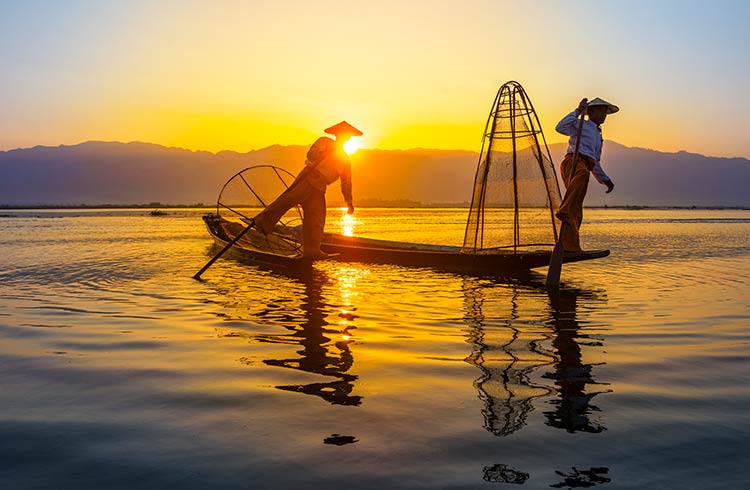
Other boats dredge up seaweed to be used as fertilizer in the floating gardens. At the far end of the lake, we visited a huge market with endless vegetables, fruit, chicken, fish, and handicrafts. The pressure to buy nice handicrafts was endless. A cheroot factory (anise flavoured), cotton, silk, and lotus weaving “factories and a hand-powered sawmill were visited.
Manhangar Pagoda was originally built in 1313. Five sacred mounds of accumulated gold leaf covering ancient Buddha images are worshipped. As in all Buddhist shrines in Myanmar, women are not allowed up on the altars.
We took a long, narrow river trip at the end of the lake to Shive Inn Dain Pagoda. Walking along a river with a big weir, you end up climbing up a big covered stair to the top with a large temple, surrounded, at last count, by 1,054 stupas. The original stupa built in 270 BC is encased in the present pagoda. The oldest stupas are crumbling brick but many are modern and all sizes.
Floating gardens. On the way back to Nyaungshwe, we stopped at a floating garden. Suspended in 6m of water, two rows of tomatoes on trellises were separated by channels. The gardens line large areas of the lake. Long tail boats loaded with cucumber, cauliflower, melons, and tomatoes carry the produce to Nyaungshwe. The cost for five of us for the ten-hour day was 18,000 kyat ($18)! The boatmen are behind the times in their charging. We gladly gave him 25,000.
MANDALAY (pop 2.5 million)
On the way to Mandalay. The 7 PM bus was a big difference from my first bus experience – a blaring TV, narrow seats with no legroom, no service, and no air conditioning. Luckily the last 5 rows of seats were empty. I put up the jump seat in the aisle and spread out full length across all the seats for a great sleep. We arrived at 1:30 AM. I had not been able to book a room but was taken to the popular A.D.1 Hotel. I got a room but was told that all were booked the next day and I would have to vacate it at 7. The lobby was packed at 6, I got my pack but was fortunately offered the pagoda room on the roof. A small cube surrounded by the restaurant, it had windows on three sides, a mattress on the floor, and a wall of Buddhist statues, all for $8. The only problem was the shared bathroom (squat toilet and a water cauldron and bowl for bathing) was on the first floor. I had two lovely sleeps in the airy room. A market is just north. It was bustling at 5:30 AM as locals buy all their produce for the day.
With a young Dutch fellow, I walked out to the massive Mandalay Palace and Fort. Sixteen blocks square, the Palace occupies a small area in the centre surrounded by an army base. A 50m wide moat surrounds the high-crenelated brick walls. Pagoda-like guard towers and entrances are on each side. During WWII, fires burned the original to the ground, but the reconstruction with 40 timbered buildings and a seven-tiered central pagoda is impressive. The solid gold objects that surrounded the king’s throne (betal holders and spittoons, arm, and chin rests, candle holders, etc) were in the large audience halls and living quarters. The museum is interesting with recreations of all the ministers of government. I’m not sure it was worth the long walk and the $10 entrance fee. An intricately carved wood monastery, all that remains of the original Mandalay Palace, was moved outside the palace and can be visited. A huge sign on the outside of the fort walls stated “THE TATMADAW SHALL NEVER BETRAY THE NATIONAL CAUSE”. Tatmadaw is the army. One of the more humorous signs I saw on a busy street was “Bicycle Lane”, now rusted and bent. It would be impossible to have a specific lane for bikes with all the double-parked vehicles and motorcycles parked everywhere.
Just north of the Palace is the 230m tall Mandalay Hill with commanding views. Buddha apparently climbed Mandalay Hill and prophesied that in the 2400th year of his faith (1857), a great city would be founded at the base of the hill, and indeed that was when the king moved the capital from Amarapura to Mandalay. A large standing Buddha points down at Mandalay.
I hired a motorcycle and driver to explore around Mandalay for the day. I have never driven a motorcycle and learning in this huge, bustling city seemed a mistake. The driver also knows where he is going. The common day trips around Mandalay are exploring the 3 ancient cities of In-wa, Sagaing, and Amarapura, and a second day at Mingun. As I had a flight on day 2, I did it differently.
Mahamuni Paya is a temple with a 4m-tall Buddha image seized from Rakhine State in 1784.
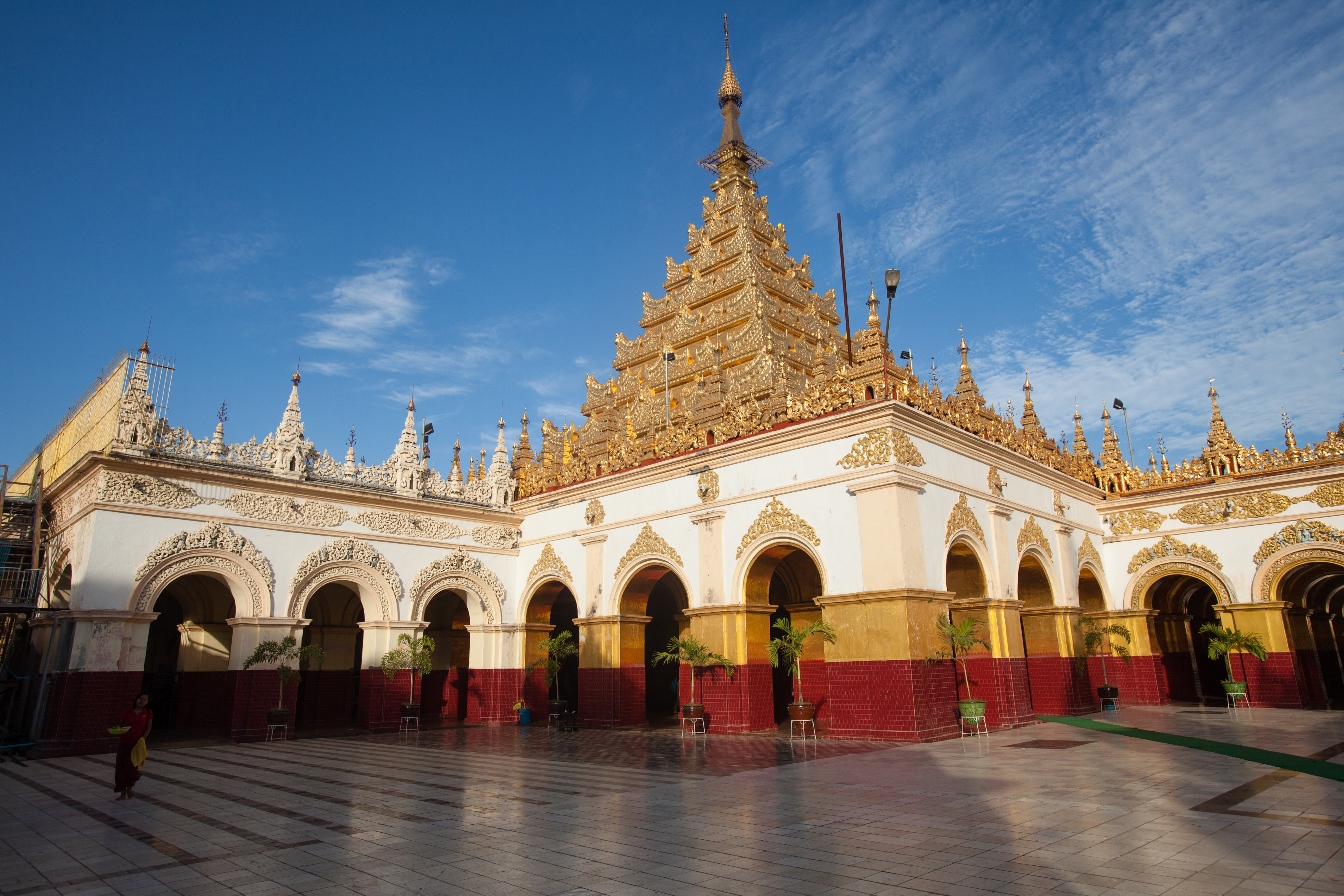
Cast as early as the first century, its story of transportation by boat and land is told by wonderful paintings in one of the rooms. It is so venerated that it is washed and its teeth brushed every morning at 4 AM by a team of monks (many tourists attend). It is now covered by 15cm of gold leaf, applied by hundreds every day. The upper part of the statue can’t be reached to apply gold but the arms have disappeared under it. Women are not allowed on the platform. In the NW corner of the compound is a room holding several large bronze statues originally from Angkor Wat in Cambodia, taken as booty from a war with Thailand, lost, and then recaptured again in 1599. One is a three-headed elephant, there are two 8-foot-tall warriors and two lions. Legend has it that touching parts of the statues that you may be having health problems with, will cure you. As a result, the patina is well-worn and holes have formed in noses and other parts.
We continued on to visit some stone Buddha carving factories and a wood carving and marionette workshop. It was then a long drive south on the east bank of the Ayeyarwady River. The wide floodplain is now covered with crops.
Sagaing. We crossed the only bridge over the river and continued north on the other side to Sagaing, the ancient capital of the Sagaing Dynasty (1315-1364).
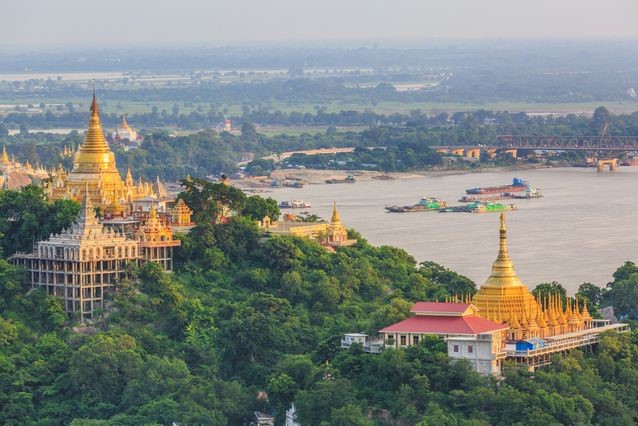
There are 500 stupas and monasteries covering the hilltops above the river. After a 30-minute climb upstairs, I reached the top of Sagaing hill and the monastery with outstanding views of Mandalay, the river, and all the surroundings. Gold stupas poke above the trees everywhere.
Mingun. Normally a full-day trip from Mandalay by crossing the river by boat at 9AM and returning at 1 PM, Mingun is home to a trio of unique pagodas. We reached it north of Sagaing in a half hour. The Mingun Paya is the remains of a planned 150m tall stupa, surely a candidate for the world’s largest pile of bricks (thought to be a billion as the huge structure is entirely brick with no earth fill). Prior to an earthquake on 11/11/2011, it was possible to climb to the top.
The Mingun Bell holds the record for the world’s largest uncracked bell (one-third the size of a bell in Moscow and 14x the size of the bell in St Paul’s Cathedral). Cast in 1865, it weighs 90 tons and is 16.3 feet wide at the bottom and 12 feet high. 200m north is the white, wavy terraced Hsinbyume Paya. The remnants of two huge lions are across the street from the Paya. The heads are gone and the backs collapsed but the rear ends with ornate plaster covering the brick remain.
Amarapura. On the way home, we stopped at Amarapura, the ancient capital of the Konbaung Dynasty (1752-1885). The main attraction is the U Pein Bridge crossing a large lake, supposedly the longest wood bridge in the world at 1.2 km.
Built of teak logs pounded into the lake bed 2 centuries ago, it is a favourite photographic site at sunset. With an uneven 2×4 walking deck, there are few railings. Tourists are rowed around the lake and bridge on double prowed boats. It was a long day on the back of the bike.
As Inwa is close to the airport, I saved it for the next day. Inwa, founded in 1354, was the historical capital for four centuries. Most visitors here rent a horse and cart to make the three-hour tour of all the ruins. Several small stupas dot the roadsides; one has ann old Buddha image. The finest site is an enormous 1834 teak monastery.
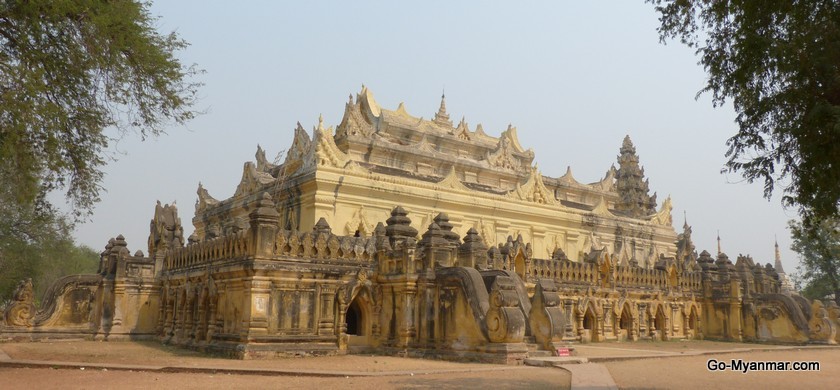
The Mandalay Airport is a 45-minute drive from city limits and is reached by a 6-lane highway. There is virtually no traffic on the best road in Myanmar. Motorcycles are not allowed on this road, so we took a dirt road and visited the Three Temples, rarely seen by any tourists. The site consists of three similar 40-meter square solid brick structures built in the 13th century, each with four arched entrances leading to a room with large sitting Buddha images. The images are unusual in that they have closed eyes and downcast heads. Some faint remnants of murals remain and the images have original paint. The most northerly two temples are in significant disrepair, but the other has been restored. Passageways connect the four rooms and stairways lead to the roof overgrown with trees.
PYU ANCIENT CITIES WHS. Includes the remains of three brick, walled and moated cities of Halin, Beikthano, and Sri Ksetra located in vast irrigated land of the Ayeyarwady River basin. The Pyu Kingdoms flourished for over 1,000 years between 200 BC to 900 AD. Remains include excavated palace citadels, burial grounds, and manufacturing sites, as well as monumental brick Buddhist stupas, partly standing walls, and irrigation that underpinned the organized intensive agriculture.
Beikthano, In the era of the Pyu city-states it was a city of considerable significance, possibly a local capital replacing Sri Ksetra. Today the modest village is noted for its hot springs and archaeological sites.
Beikthano, with direct land access to the well-watered Kyaukse plains to its northeast, is the oldest urban site so far discovered and scientifically excavated site. Its remains—the structures, pottery, artifacts, and human skeletons—date from 200 BCE to 100 CE. Named after the Hindu god Vishnu, the city may be the first capital of a culturally and perhaps even politically uniform state in the history of Burma. It was a large fortified town (300 hectares) with rectangular (3 km by 1 km) walls that were six meters thick. The main entrance led to the palace, which faced east. Stupas and monastic buildings have also been excavated.
Beikthano is located 12 miles west of Taungdwingyi Township on the Taungdwingyi-Magway Highway. 450 feet above sea level.
Sri Ksetra was the capital of the Pyu dynasty of Vikrama. The city was circular with walls enclosing about 46 km2 (18 sq mi), making it the largest walled city in Southeast Asia during its peak. The city contained both housing, farms, waterways, and tanks.
It is not known when precisely the Pyu abandoned Sri Ksetra and moved northward. It is speculated that their decline was due to the growth of the Irrawaddy river delta, cutting it off from coastal trade, and also from Mon and later Tai Shan incursions. Burmese chronicles state that when Anawrahta invaded the southern parts of modern-day Myanmar in 1057, he ordered the ruins of Sri Ksetra to be destroyed to prevent rebels from sheltering there. The Burmese came to call the old Pyu center Pyi.
Hanlin. In the era of the Pyu city-states, it was a city of considerable significance, possibly a local capital replacing Sri Ksetra. The archaeological sites are located above the village 12 miles (19 km) to the southeast of Shwebo. One road goes for 9.7 km from the bus terminal to Bo Te village and then along a rough road. The land is generally barren except for some irrigated areas.
They spoke the Tibeto-Burman languages. Trade was conducted with China and India. The Pyu’s authority extended to eighteen kingdoms, most of them in the southern region of Myanmar. They were refined in their behavior, dress habits, culture, and art, and were Buddhists of the Sarvastivada school. The architectural styles which evolved from the 11th to 14th centuries are evident in the Pagan area. Initially, their capital city was Sri Kshetra, at the northern edge of the Irrawaddy River delta. In the 7th century, they moved their capital to Halingyi which is in a dry zone. Their southern neighbours were the Mon people who were followers of Theravada Buddhism. Over the years Pae culture was overshadowed by the Bagan culture.
The Shwegugyi Pagoda is now encircled by agricultural fields with many ancient stupas built of bricks.
The walls had twelve gates and a moat. Three sets of standing stone slabs date to the 2nd AD are indicative of the megalithic culture. The Southern Gateway has been dated to about 200 AD.
At a museum, see human skeletal remains, pottery, jewelry, and bronze rattles laid in graves in a series of rows, silver coins, gold ornaments, and bricks with inscriptions of texts. The Pyu alphabet with links to Sanskrit and the present-day Bamar language, is inscribed on a tombstone.
The new Mandalay Airport is primarily domestic with few international flights. Along with the road leading to it, it has a lot of wasted space. Despite having great difficulty getting seats for this flight, there were 9 empty ones on this 44-passenger jet (go to the Air Bagan office on 78th street in Mandalay). I sat next to a 17-year-old girl returning home to Bhamo after receiving chemotherapy for leukemia. The farthest north town on the Ayeyarwady River is Myitkyina, accessed only by rail. It is possible to go, but the surrounding area with tribal villages, and the river down to Bhamo is closed because of civil strife. It is also impossible to go outside a 5km radius of Bhamo for the same reason. We landed at the small airport and took a shared jeep the 2 km into town and the Friendship Hotel. It is large and nicely appointed. The front desk arranged our tickets on the government ferry for the next morning. I missed out on obtaining a cabin for the two-day/one-night journey down the Ayeyarwady down to Mandalay (which turned out to be a lucky break). With two young Germans, we walked around town to see the usual stupa, and the Thousand Monks, a single file line of monk statues, each slightly shorter and with different features than the one before, following a large Buddha image. The breakfast put on by the hotel the next morning was over the top – imagine a breakfast buffet in a large hotel for hundreds (there were only 8 of us). Speedboats also make this river trip but since an accident last year, foreigners are not allowed.
We departed at 6:25, each with a shopping bag of food supplied by the hotel for the boat trip.
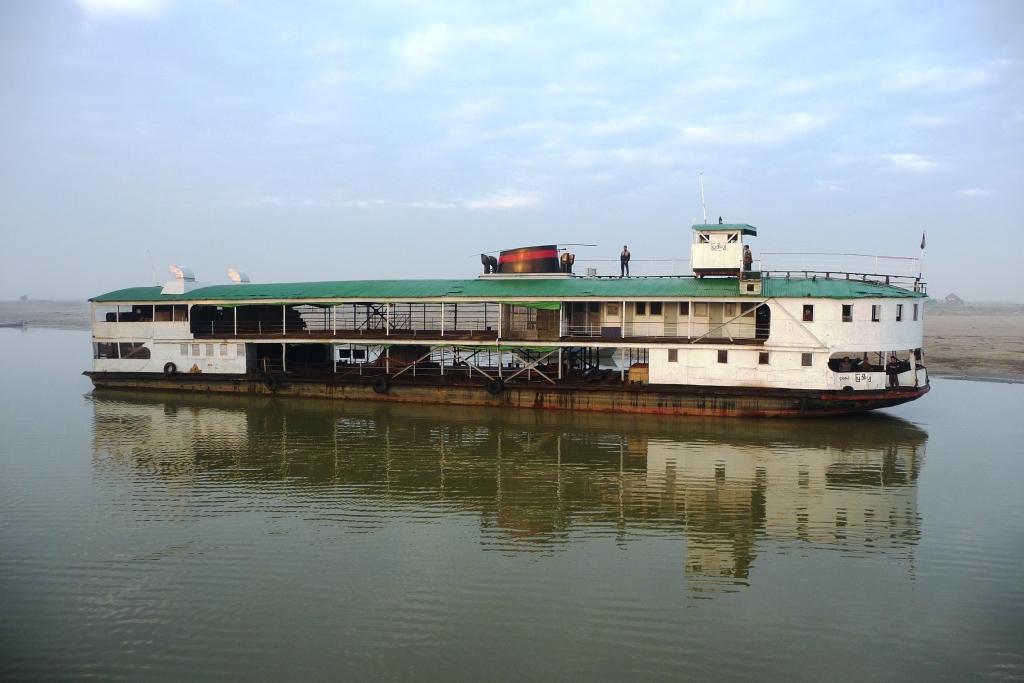
Loaded mostly with locals, we departed at 7 in the relatively narrow river. Because it was low water, the ferry needed to follow channels and make big loops back and forth across the river. Barges carrying freight and small fishing boats were the other main traffic. Two hours down, we entered the second 7.5km long defile of the river famous for its natural beauty. Nat’s Face Mountain is a 985-foot cliff where the river is at its narrowest. The Parrots Beak is a small rock jutting out from the cliff face in the shape of and painted like a parrot. The local people regard it as a water level marker. When the water level reaches the beak, it is usually not possible for boats to go upriver because of the very strong current. The depth of water in the rainy season here is 180 feet. The river is dotted with small villages and rattan houses. After the second defile, a famous golden pagoda is on an island in the middle of the river. After this, the river widens out with low banks and flat land extending to some low hills to the west. The ferry stopped at two towns where we were able to buy food (the food on the ferry is not great). The ferry has 3 levels with an open-air deck on top. There were no chairs and we sat on the deck in the hot sun. The second level has the cabins and an a big open space mapped out in numbered rectangles assigned like seats in a bus. This area was full of locals who had settled in for the long journey. A raised wooden platform at one end is reserved for foreigners without cabins to sleep on.
Rather than continuing all the way to Mandalay, I got off the ferry with the two Germans at Katha, about 9 hours downriver. The views had been boring and I did not relish sleeping on the hard platform with no mat. It would have also been nice to have a covered area with chairs to lounge on to watch the scenery pass by. I was also looking forward to the train ride from Katha down to Mandalay. George Orwell’s ‘Burmese Days’ was based in Katha when he was stationed here in 1926-27. I caught a rickety taxi for the one-hour drive to Naba over one of the most horrendous roads ever traveled – confluent potholes, rocks, and stream crossings. After buying my ticket, I wandered around enjoying all the street food snacks at the railway station. The station was crowded with bodies sitting and laying all over the platform.
Myanmar’s railways were inherited from British times and haven’t been upgraded since, resulting in an uneven bed and warped rails. Sleeper cars aren’t available on this line and foreigners must buy upper-class tickets in $US at 10 times the prices for locals. It is impossible to describe the 11-hour ride. It was like a midway ride – at times the cars swayed a few feet from side to side, and each time the car passed over a joint, the car lurches like it hit a pothole. At top speed (rarely above 25 km/hour), I counted 100 lurches per minute. On some particularly bad stretches, you almost leave your seat with each one. And it was nonstop for the entire time; no piece of track was minimally smooth until we approached Mandalay. Every passenger had their luggage in front of them taking up most of the leg room. I had great difficulty talking the teenage monk across from me to move his bag taking up most of my legroom. With nonreclining seats and still insufficient legroom to stretch out, I did not sleep a wink. Amazingly, most of the locals seemed to have no problem as their heads bobbed up and down several feet each time. The lights were also on full for the entire night. It was so hellish that it almost became humorous. Pairs of seats face each other and I had a good time with the other 7 passengers and two babies in our ‘group’. I was the only foreigner on the train as the Germans stayed in Katha overnight. Certainly, it was a journey I will never forget and part of the Myanmar experience – easily the worst quality railroad in the world. Exhausted on arrival in Mandalay at 6 AM, I went to my hotel and hit the sack.
Many foreigners take the 9-hour boat down the Ayerarwady to Bagan. I took the bus for the five-hour ride. The Bagan Archaeological Zone stretches for 41 sq. km and costs $15 (or 15 Euros or 16,000 kjat) instead of 10 elsewhere. Despite centuries of looting, neglect, erosion, earthquakes and dodgy restoration, the temple-studded plain remains impressive. In a 230-year building frenzy ending in 1287 and the Mongol invasions, Bagan’s kings commissioned over 4000 Buddhist temples.
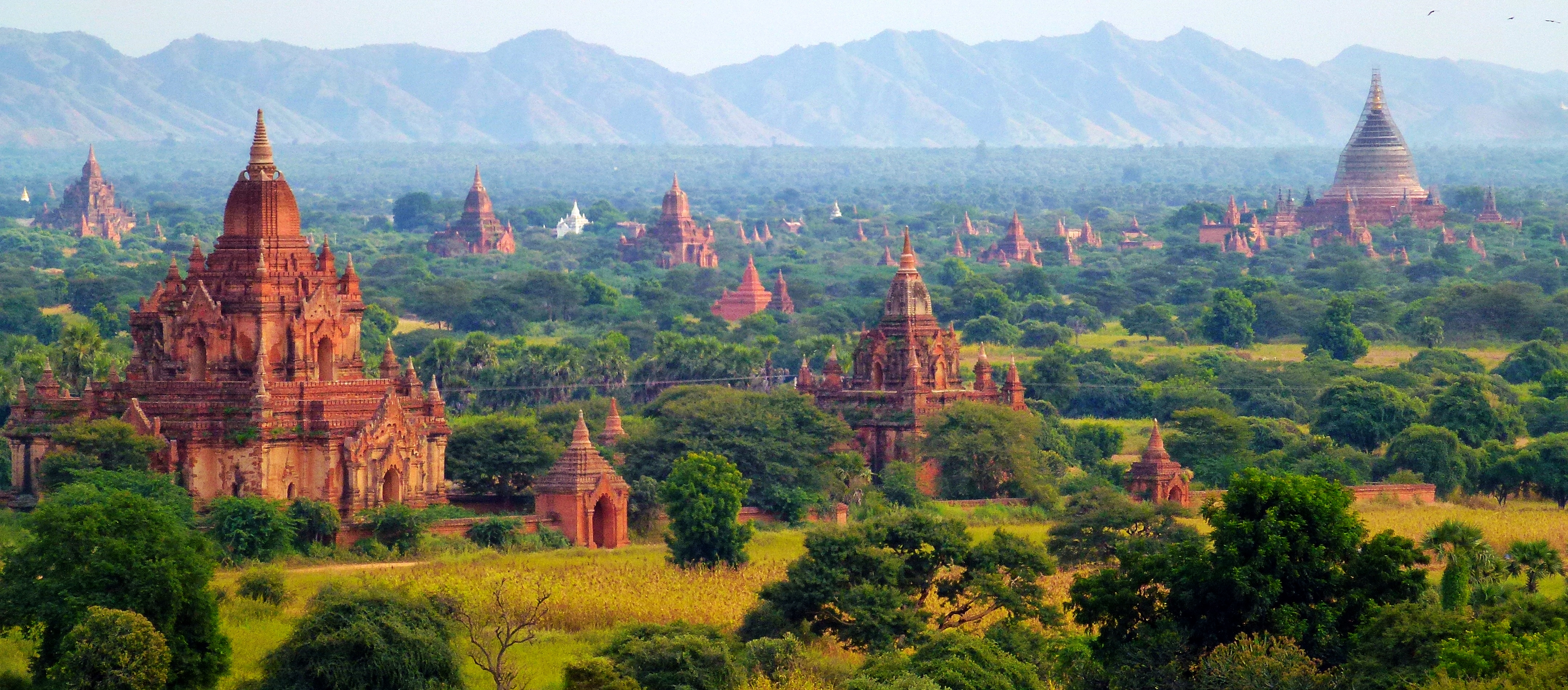
Many restoration projects have resulted in a compromised archaeological site that can barely be described as ruined. But that is why it will never receive Unesco World Heritage status. It still remains a wonder. The best temples give a sense of what the place was like at its zenith, while others conceal colourful murals and hidden stairways that lead to exterior platforms and jaw-dropping views across the plain.
I shared a double room with a young American from Colorado, in Nyaung U. We had a great room with all-bamboo walls, hardwood floors, aircon and a fan, a bathroom and included breakfast for $20 (Eden I Hotel). This is one area where it is not necessary to reserve a room, as there are many places in the backpacker budget range that are not listed on Agoda. We ate and spent a great deal of time at the Grand Empire Hotel for its above-average wi-fi. They did not mind us in their air-conditioned lobby mooching the internet.
Ideally plan the temple viewing around a dawn/dusk visit, spending the hot midday somewhere cool.
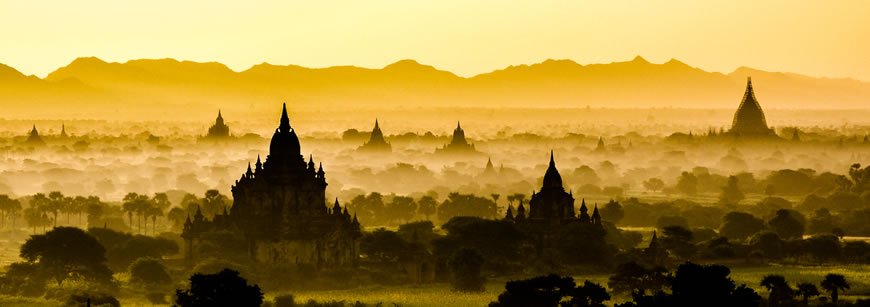
We rented bicycles and visited many small temples lining the river and the walled city of Old Bagan. On the North Plain, Ananda Pahto, built in 1105, is probably Bagan’s top draw. Here and in many other temples, the murals retain their bright colours.
Shwesandaw Paya is a steep white pyramid with 360-degree views of all the temples and was packed for sunset.

Several temples have interior interconnecting passageways and steep, narrow stairways taking you onto the roofs. There are so many structures that it gets a little redundant.
Golden Rock. I took the night bus from Bagan to Yangon, unfortunately getting the back corner seat, the only one on the bus that did not recline. Arriving at 5 AM, I immediately got on the 5:30 bus to Bago, arriving at 7. Instead of a 7000 kyat bus taking 3 hours to Kyaiktiyo, I shared a taxi that took 2 hours for 20,000 kyat return. It was then 2500 kyat each way up the 11km switchbacking road in big trucks to the top of the mountain and the Golden Rock. There was a massive rainstorm and everyone got soaked in the open-air trucks. The giant, gold-leaf-covered boulder does appear to be hanging precariously, but the small metal stupa on top (supposedly contains a Buddha hair donated by a hermit in the 11th century, the hair was salvaged from the bottom of the sea and brought here by boat!!!) and lots of gold leaf applied to the back are tipping the balance to ensure it stays where it is, despite several earthquakes. Pilgrims come here in the thousands.
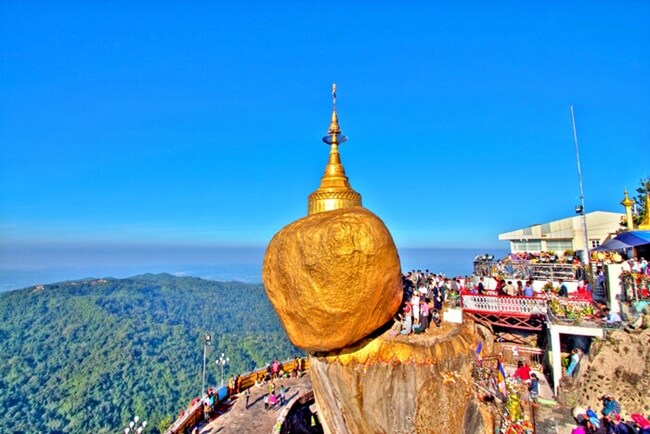
Back in Bago, I slept for the next 12 hours. I had arranged a motorcycle tour of Bago for the next AM. There is a 55m long lying Buddha 9m larger than the one at Wat Pho in Bangkok (the soles of each foot are decorated with 108 marks representing the three worlds – 59 of the inanimate world, 21 of the animate world, and 28 of the conditional world), two stupas (one 14m taller than Shwedagon Paya in Yangon) and several other temples. Big is better in Buddhism. I also went to a cheroot factory and saw a big, holy python. I am not sure it was worth the cost and time to visit the Golden Rock. Back in Yangon for 36 hours prior to my return flight to Bangkok, I relaxed and had a day off.
The Myanmar style of Buddhism is unique. Large stone lions flank the large stairways leading up to a raised platform on which the gold stupa sits. The stairways are usually lined with vendors. Temples line the outer walls of the platform, usually with many Buddha images. Altars are simple with flowers, holy water, and sometimes fruit. Flashing neon lights are behind Buddha’s head. There is no pantheon of gods – only one, Buddha. The interior of the temples is simple often just painted gold. Dioramas with statues of monks or disciples are frequent. The roof lines, however, are ornate with multiple tiers and goldcrests. Most stupas have corners for eight days of the week. The stupas are always painted gold and have ornate metal cones on top. There are no entrances into the stupa proper – they are solid. People walk clockwise or counterclockwise, it doesn’t seem to matter. There are no prayer wheels or prayer flags. Just as everywhere else, people pray with prayer beads of 108 beads and keep up a droning chant.
Male monks wear maroon and the frequent nuns wear pink. They enter the monastery as little children, often from families with too many children to support. Up at five, they make the rounds of the village or city with their large bowls, begging for food from the members of the town. They do not eat after noon. They seem very worldly – have smartphones, ride in taxis, and shop in stores. The internet cafe I used in Mandalay always had at least 10 teenage monks using Skype, and Gmail, and playing video games. They receive a normal education and sometimes college degrees and Ph.D.’s. Foreign teachers said they were normal, mischievous boys but also keen students.
Some observations about Myanmar. The people are very sweet and pleasant. A smile is returned especially by women. Everyone wears a longhi, as in India. All the men chew betel and have red/black stained teeth. The only books seen were simple trashy novels, and I never saw anyone reading. Poverty is rife and it seems that those not in the tourist industry, make their livelihoods as street vendors.
The strength of the Myanmar people must be admired. They have put up with an incredibly repressive regime that has stifled their economy and lives. At one time at the top of all countries in SE Asia, now it is at the bottom of the economic heap. Prior to two years ago it was extremely dangerous to say anything negative about the government. It is estimated that one out of ten citizens was a paid informant of the army, and even negative thoughts were risky. I had a few conversations with locals about the time. They are placing tremendous hope in Aung San Suu Kyi, now leader of the National League for Democracy. After 15 years of the last 24 years in house arrest, she was released in 2010. The October 2010 election was seen as simply replacing old wine in new bottles. The UN called the elections deeply flawed. Because of her many connections with foreign leaders, she wields the only power for change.
The Burmese people have not become tired of tourists. A smile is always returned. Honesty is universal and we never had any fear of theft. I had great relationships with some of the motorcycle taxis that I used and tried to give generous tips.
I will give a suggested itinerary based on my experience and that of others. The scope of your trip will depend on your travel style and number of destinations, of course. Most everyone flies into Yangon where everything can be seen in one day. Shwedagon Paya should not be missed. Take a night bus to Bagan, rent a bicycle, and see the sunset and sunrise and the main temples. Take the bus to Kalaw and hike over 2 or 3 days to Inle. Rent a bicycle, go to the winery and continue around the lake and take a boat back to town. Rent a boat the next day with 4 others and spend the whole day exploring the lake. Try to be there in the second week of November and see the fantastic Taungii Balloon Festival. Take an overnight bus to Mandalay. Visit the three ancient cities of Amarapura, Inwa, and Sagaing one day and Mingun, a second day. Another day can be spent going to Mahamuni (try to wake up at 4 AM to see the washing of the Buddha image), the Palace, and Mandalay Hill. Fly to Bhamo and take the ferry down the Ayerawady River to Katha to see the most interesting part of the river. Disembark here, take a taxi to Naba, and catch the train back to Mandalay to experience the worst train ride in the world. From Mandalay, go to Pyin Ol Lwin to see a colonial hill city, and continue on to Hsipaw to trek for a few days. Return to Mandalay and go to Monywa via Pakokku to see the world’s second-largest standing Buddha. Fly from Mandalay to Sittwe on the Bay of Bengal and take a boat to Mrauk U to visit the ancient city. Fly back to Yangon and either visit Bago and the Golden Rock at Kyaiktiyo. Fly to Kengtung to see interesting hill tribes if you can get a permit and cross the border into Thailand or fly to Myeik on the southeast and cross into Thailand here at Kawthoung going to Ranong, Thailand. If you did all that, it would be a busy 4 weeks.
Myanmar’s Shame – 2014. An article excerpted from Time Magazine.
Sittwe, a drowsy town in Western Burma, is a shattered place. I was first here five years ago, back when ethnic Rakhine Buddhists sold vegetables next to Muslim Rohingya fishermen. At the time. a Buddhist abbot and a Muslim cleric blessed me in whispers, as both spoke out against the repressive junta that that ruled Myanmar – for nearly half a century.
Today, Sittwe, like much of the surrounding state of Rakhine, exists in virtual apartheid. There are no Muslims at the market. Their mosques have been bulldozed, even though one state official in late 2012 told me with a smile that nothing had been destroyed, nothing at all. Did he think I could not see the rubble, with torn pages of children’s prayer books underfoot? Evicted from their homes more than 140,000 Rohingya now live sequestered behind checkpoints. Disease festers in these crude camps. In June a top UN aid official who traveled to Rakhine said she had never before “witnessed such a level of human suffering.” The UN estimates that 86,000 people, mainly Rohingya have fled by boat in the two years since clashes erupted between the majority Buddhist and Muslim populations.
In the 1980s, the all-Buddhist military junta stripped most Rohingya of their citizenship, claiming that they were recent immigrants from neighboring Bangladesh. But many Rohingya have lived for generations in Burma. The country is now ruled by a quasi-civilian government praised by the West for its reforms. Its treatment of the Rohingya – as well as some other Muslim minorities – could be considered close to ethnic cleansing.
Meanwhile, conditions worsen in the Rohingya camps spread out across the salt flats of the Bay of Bengal. The Buddhist abbot in Sittwe, who so inspired me that I brought my children to meet him, speaks now not of the government’s failings but of his hatred of Muslim hordes. A town like Sarajevo, once of two faiths, has cleaved beyond belief.
